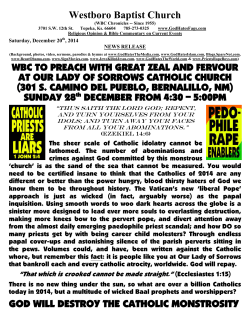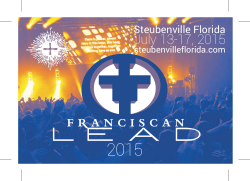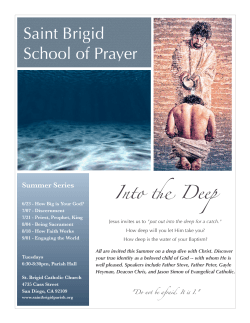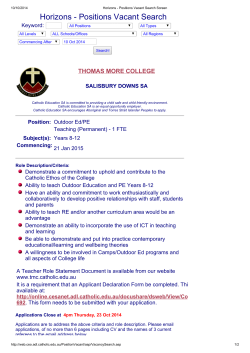
Our Story So Far - Forward Together in Hope
Our Story So Far A Brief History of the Church in this Area The Early Church Icon of St Cuthbert Written by Maureen Malone Insofar as our Christian Heritage is concerned, the towering figures of Bede, Wilfrid, Hilda, Aidan and Cuthbert are not just hugely influential local people, but are of an international reputation. It is said that the library available to St Bede in Jarrow was as big as any in the Christian world outside of Rome. But even in those days, there were little local difficulties. The Vikings arrived on Lindisfarne in 793AD like ‘fiery dragons flying across the firmament.’1 Some people at the time believed that the raid was brought on by ‘unheard of evil practices’ such as the way the monks ‘dressed, the way of wearing hair and the luxurious habits of the princes and the people.’2 The faith of the people survived, however, and continued to thrive, though it has never been plain sailing. Magnificent monasteries (Benedictine, Cistercian, Carthusian) were established throughout the country bringing their traditions of prayer, liturgy, education, hospitality, animal husbandry, agriculture and care for the sick. Lindisfarne Priory (Photo: Kathryn Turner) 1 2 Anglo Saxon Chronicle Alcuin to Bishop Higbold of Lindisfarne (780-803). Forward Together in Hope – Our Story So Far – March 2015 The landscape of our Diocese, indeed of the whole country, was peppered with religious houses. In the years between 1536 and 1540 there was one religious house for every parish church in this land. In Newcastle during this time there were four friaries, Franciscan, Dominican, Augustinian and Carmelite. All were suppressed at the beginning of 15393. The Reformation – The Tudors In the middle of the 16th century King Edward VI (1537 – 1553) tried to remove every trace of Catholicism from the realm – pretty well all altars, crucifixes, statues, vestments, paintings and glass were removed. Much was wantonly destroyed and what exists today is probably around only 5% of England’s medieval heritage. In 1559, Queen Elizabeth I issued her ‘Settlement of Religion’ which basically looked ‘Catholic’ with its retention of bishops, vestments, candles and the like – but which had at its heart the assertion of the English Crown’s supremacy over the Church. Fairly soon, there were no ‘Catholic’ bishops in the country. In 1568 a priest from Lancashire, Cardinal William Allen made provision to train English priests (and laymen) abroad in Douai. He also founded the Venerable English College in Rome. From these two houses of formation, many priests returned to the country and were martyred. These men lived and moved in secret, supporting Cardinal William Allen the faith of the people and celebrating the sacraments with them. By the end of Elizabeth’s reign in 1603, there were probably around 40,000 demonised, disorganised and dispirited Catholics in the country – reduced to about 2% of the population. 3 David Milburn – History of the Diocese, Diocesan Website Page 2 The anti-Catholic penal laws enacted under Elizabeth included double taxation, sequestration were, of course, servants and labourers everywhere. The Catholics were to be found in almost all occupations available in the region. This may be thought surprising given that for most of the period Catholicism was a proscribed religion. They only found it possible to live undisturbed as members of their local communities because, for all practical purposes, they were just like everybody else. The Stuarts A Recusant Chalice of property, disfranchisement, and exclusion from government service, the armed services, the universities and the professions. Catholic worship in public was forbidden and fines were imposed for non-attendance at Anglican services. Catholic education was banned. In the North East Catholics were thinly and widely spread but in every respect they were indistinguishable from their neighbours. Apart from a few wealthy landowners, the majority (90%) were ordinary folk earning a living as employees in one way or another. Large numbers of yeomen and agricultural workers - millers, cottagers, gardeners, husbandmen and herdsmen - were to be found in all rural parishes. The urban parishes had butchers, shoemakers, carpenters, shopkeepers of all kinds and innkeepers; there were midwives, apothecaries, barbers and nurses. Fishermen and other seafarers were working out of the ports. Industry was represented by unskilled, semi-skilled and skilled workers: wheelwrights, engine wrights, millwrights and so on. Catholic pitmen, sinkers and staithsmen worked in the collieries. There James I relieved Catholics for their support by removing the main threat to their existence, namely, persecution. He lived to rue the day when there was a resurgence of Catholicism and some pretty hot-headed responses – the Gunpowder Plot of 1605 springs to mind. Catholic families in this region suffered. Thomas Percy was killed resisting arrest, Francis Thomas Percy Radcliffe of Dilston and Roger Widdrington of Cartington were detained but the charges against them were never followed up. However, many prominent Catholics fell away from the faith in order to preserve the ownership of their estates and property. During this time, from Cleveland to Northumberland, Catholic gentlemen helped to organise Mass Centres. Priests became tired of being harassed and gravitated to the rural retreats of the gentry to act as their chaplains. The more populated region of Tyneside also possessed Mass Centres, and some new houses in Gateshead and Durham provided accommodation for a priest to live and serve the local people. The Gunpowder Plot Conspirators Forward Together in Hope – Our Story So Far – March 2015 Page 3 Given that there had been no Catholic bishop in the country since 1559, it seems strange that it took until 1623 for Rome to appoint one to oversee the whole of England, Wales and Scotland. He didn’t last too long because opposition from the landed gentry, the Jesuits and some secular priests led to his departure. He did, however, leave a Chapter (a council of senior priests) which functioned as the governing body of the Church for many years. At this time there were 12 priests (including 2 Jesuits) in Northumberland and 16 in Durham. The Diocesan priests were associated mainly with the landed gentry, but the Jesuits associated with the urban poor, many of whom came to be part of the Catholic community. Many people in the Diocese will remember the name ‘Corby Hall’, a Jesuit retreat centre in Sunderland, named after Ralph Corby SJ who was arrested in Hamsterley in July 1644 and executed at Tyburn in London that same year. No more priests were executed after 1654 but the fact remains that it is only 360 years since the last Catholic priest was executed in this country. There was a strong reaction against Catholics and both the Newcastle chapel and church of the Jesuits in Durham, were almost destroyed. More restrictive legislation against Catholics was then introduced, banning them from government, administration and the armed services. One good thing to emerge from King James’ attempt to restore Catholicism was the establishment of a Vicar Apostolic for England and Wales – a bishop appointed by and directly answerable to the pope in all matters. It soon became apparent that he could not do the job alone and 3 others were appointed, one of whom was made responsible for the whole of the North of England – Lancashire, Yorkshire and the northern counties – an arrangement which remained in place for almost 150 years. The 18th Century The following century was one of gradual toleration of Catholics, apart from a couple of rebellions - in 1715 and 1745, - but only the Catholic (and Anglican) gentry in Lancashire and North East England took part. Bonnie Prince Charlie Durham Market Place – A site of Catholic executions Newcastle’s first known Catholic chapel opened its doors in White Hart Yard (Bigg Market) in 1685, the first year of the reign of King James II. He authorised the return of the celebration of mass in the King’s Chapel in Whitehall and other newly built churches. But he was over-eager in his enthusiasm to have Catholics in posts from which they were excluded by law, and lost huge support for imprisoning the Archbishop of Canterbury and other Anglican bishops in the Tower of London for refusing to read a declaration granting full civil rights to other denominations. He was eventually deposed and went into exile on the continent providing parliament with a (probably unconstitutional) pretext to declare William (of Orange) and his wife Mary (James’ daughter) joint rulers. Forward Together in Hope – Our Story So Far – March 2015 The young Earl of Derwentwater of Dilston Hall was beheaded as a result of the ’15 rebellion, and Catholic chapels in Gateshead, Newcastle, Durham and Hardwick Hall were all damaged by riotous mobs. The Vicars Apostolic inaugurated an era of moderate expansion of the Church. Legally, priests were still outlaws and public worship was forbidden but, as time went by, the necessity for clandestine services decreased and the Church quietly established a network of permanent missionstations and most Catholics could have regular access to the sacraments. In rural areas private missions would be established and financed by local middle class benefactors and/or the clergy themselves. The chapel formed part of the priest’s house and was a plain simple building, usually up a side street or alley, without any Rt Rev Richard Challoner Vicar Apostolic 1758-1781 external ecclesiastical Page 4 identifying feature. Internally, chapels were equally plain and the celebration of the liturgy was restrained. By 1767 there were 28 secular and religious priests working in the region, responsible for some 2,100 Catholics in Northumberland, and 2,700 in Durham. During the 18th century, the number of Catholics in the country as a whole rose gradually from 60,000 to around 80,000. In 1778 a Relief Act allowed Catholics to own property without additional taxation or the threat of dispossession. In 1791 a second Relief Act authorised chapels under license, and in 1829 Catholics were fully emancipated and allowed to vote and sit in parliament. The final step of restoring the Church to normality – the Restoration in 1850 of the hierarchy extinguished at the Reformation – proved controversial. There was some very strong reaction against the Restoration, which became known as ‘Papal Aggression’, with The Times leading the charge in London. Even the Evening Chronicle in Newcastle ranted on for months about ‘self-seeking Romanism’. But within a couple of years, the controversy died down and the newly appointed bishops could begin to get on with the painstaking work of developing their new dioceses. The story of Catholic education is fascinating during this time. From the early 1600s there were clandestine schools, often conducted in rural barns. A ‘select academy for youth of the higher class’ was established in the 1650s somewhere in Northumberland by the Jesuits. In the same county a Catholic schoolmaster taught at Netherwitton in 1680. Under King James II new schools opened at Durham (boarding) and in Newcastle. The French Revolution, from 1789, forced the expatriate clerics, nuns and lay folk to flee France and return to England. A large number of French priests were also expelled and many came to the North East: in 1796 there were around 200 in Sunderland, 100 in Berwick, 30 at Heddon on the Wall, and 15 in the half-finished priest’s house at Brooms. The majority returned to France in 1802, but nine stayed on to work in the region and they made a very significant pastoral contribution during this particular time of transition. Forward Together in Hope – Our Story So Far – March 2015 The 19th Century In 1830, there were 18 mission centres in Northumberland and 12 in Durham. By 1839, there were new chapels and a further expansion of Catholic presence due largely to the influx of people from famine-stricken Ireland. By 1850 the Catholic population of the Northern District as a whole increased to 250,000, with 190 missions and 242 chapels. The huge increase in the Catholic population had led, in 1840, to the division of the Northern District, leaving Northumberland, Durham, Westmorland and Cumberland to form a separate vicariate. Ushaw College 1858 (Photo: Peter Seed) In 1804, Ushaw College was founded (originally in Tudhoe Academy c.1787) from the seminary in Douai. It continued what Douai had done and opened its doors to both lay men and men who were considering ministerial priesthood. One of its first students was Nicholas Wiseman, who was to play a hugely prominent role in having local bishops re-established in the country. In 1850 the hierarchy was restored, with Wiseman as the first Cardinal Archbishop of Westminster. Our first Bishop of Hexham (‘Newcastle’ was added in 1861) was William Hogarth. He continued to live in Darlington – he simply didn’t like Newcastle – and fancied building his Cathedral in Hexham. Rt Rev William Hogarth 1786-1866 Buried at Ushaw Page 5 However as we know, Augustus Welby Pugin’s St Mary’s Church in Newcastle (1844) became the Cathedral Church of the Diocese. The Cathedral Church of St Mary, Newcastle (Photo: Karen Burbridge) The story of the next century is largely one of major expansion in the Catholic population, the number of missions and schools, the work of the religious orders in education as well as social work (noting that the Church in this respect was in the vanguard of feminism). The combined effects of industrialisation, Irish migration and the Oxford Movement (a movement where High Church Anglicans became committed to ‘Anglo Catholicism’) created new circumstances which needed a major reorganisation of the Church. born in Ireland rose to between five and nine per cent in the mid-1870s, but they were increasingly accepted as productive and respected members of the Church and society. They were no longer the poor relations of the English Catholics but had become their equals, contributing financially and organisationally to parish life. The Oxford Movement introduced into the Church a body of people with an enthusiastically ritualistic manner which chimed with the Romanism or Ultramontanism (fascination with all things ‘Roman’) of the newly restored hierarchy. Church practice which had been plain and simple, and highly suited to the English temperament, became what might be called Italianate – a highly demonstrative romantic fervour – with incense burning, high masses, processions, and so on, practices (sometimes termed the Italian mission to the Irish) hardly known in recusant England. This went along with English medievalism and its architectural style much beloved by Pugin and his many devotees. Industrialisation gave rise to the movement of population from the rural areas into the towns and cities. The clergy were only too pleased to leave their confined and secluded rural missions to move into the rapidly industrialising towns and cities and minister to the increasing numbers of working-class and middle-class Catholics. Pugin’s interior design of the Cathedral Church of St Mary, Newcastle (Photo: Karen Burbridge) Irish workers had always migrated into England over the years, but the potato famines of the 1840s drove ever larger numbers to leave so as to find work in the rapidly expanding industries in the north of England. The labour-intensive industrial take-off of mid-Victorian Britain could not possibly have been achieved without the Irish migrant workforce, and the Empire could not have been sustained without the Catholic soldier. By 1850 the majority of Catholics in the north were of Irish origin and they could be found in most towns. The proportion of the Catholic population The old hole-in-the-corner chapels were mostly replaced by large Gothic-style churches built in prominent locations designed by the leading architects of the day and financed almost entirely by public subscription. Church dedications were usually to St Mary and the medieval English saints and in that way the modern church deliberately proclaimed its continuity with the preReformation institution. From this point dedications to St Patrick, Our Lady and continental saints were increasingly used. The bishops were well aware that the preservation of faith depends on education and instructed their priests to provide schools before churches. Hence a number of buildings served the dual purpose of school and church. A number of religious orders of nuns and monks opened schools. Forward Together in Hope – Our Story So Far – March 2015 Page 6 The years after 1850 can be seen as a period of consolidation during which the three strands of Catholicism – English, Irish and convert Anglican – merged into a more or less cohesive whole and embarked confidently on a building programme of churches, schools, orphanages and homes for the aged poor. Catholics across the region were taking their place as mayors, councillors, guardians, magistrates and other prominent positions in public life. In 1900 the Catholic Church could look back on over a century of uninterrupted development. In the mid-19th century the small community of English Catholics was faced with a large influx of Irish migrants and convert Anglicans which dramatically changed the Church they had known. Despite their very different traditions, together they rose to meet the pastoral challenges which the new situation presented. That they were so successful is, in many ways, the most remarkable achievement of the Church in the nineteenth century. The ‘Golden Age’ It may be that the ‘golden age’ of modern British Catholicism came in the years between the two world wars when large numbers of Catholics – Belloc and Chesterton, Knox, Sheed, Ward, and many others – became prominent figures in the public and cultural life of the nation. Indeed, so imbedded in national life have Catholics become since then that the fact that a Gilbert Keith Chesterton well-known person is 1874-1936 a Catholic passes unremarked, except among Catholics themselves who seem as if they can hardly believe it. In our Diocese the community we call Church continued to flourish. We benefited enormously from a great number of priests who came from Ireland to minister in this part of the world. The last Diocesan priest to come from an Irish seminary arrived here in 1976. Diocesan Secondary Schools’ Summer Festival 2014 at the Youth Village (Photo: Daniel Marshall) Diocesan schools. Our response to the spiritual needs of young people has been enhanced over the last 20 years by the presence in the Diocese of the Youth Ministry Team with its focus on retreats both in schools and in the Youth Village – over 12,500 young people a year benefit from the ministry of the Team. In 2011, Ushaw, the seminary founded in 1804, closed its doors to the training of future priests. Their formation now takes place in Birmingham, Spain and Rome. The college is currently used by the University of Durham and there are early plans for its development as a future College of the University with perhaps a very special focus on Catholic Studies, ethics and Catholic Social Teaching. What this brief ‘fun-run’ through the Catholic history of the North East shows is that our Church has never ever been ‘static’. It has never been fixed, it has been in constant change, has always adapted to differing circumstances. There have been men and women of great courage, others have drifted. We need to look carefully at the circumstances we are in now and explore how we can flourish in the future, always remembering that the vocation of each of us is to become a disciple of Jesus. Acknowledgement Thanks go to Leo Gooch and Fr David Milburn for their great help with this overview of our Diocesan history. The Diocese has 129 primary schools, 6 first schools, 4 middle schools and 20 secondary schools. There are over 53,000 pupils in our Forward Together in Hope – Our Story So Far – March 2015 Page 7 Diocese of Hexham and Newcastle, Department for Development and Renewal Tel: (0191) 243 3304 E-mail: hope@diocesehn.org.uk Web: www.hope.rcdhn.org.uk ©Diocese of Hexham and Newcastle – March 2015 Also available in other formats
© Copyright 2025









